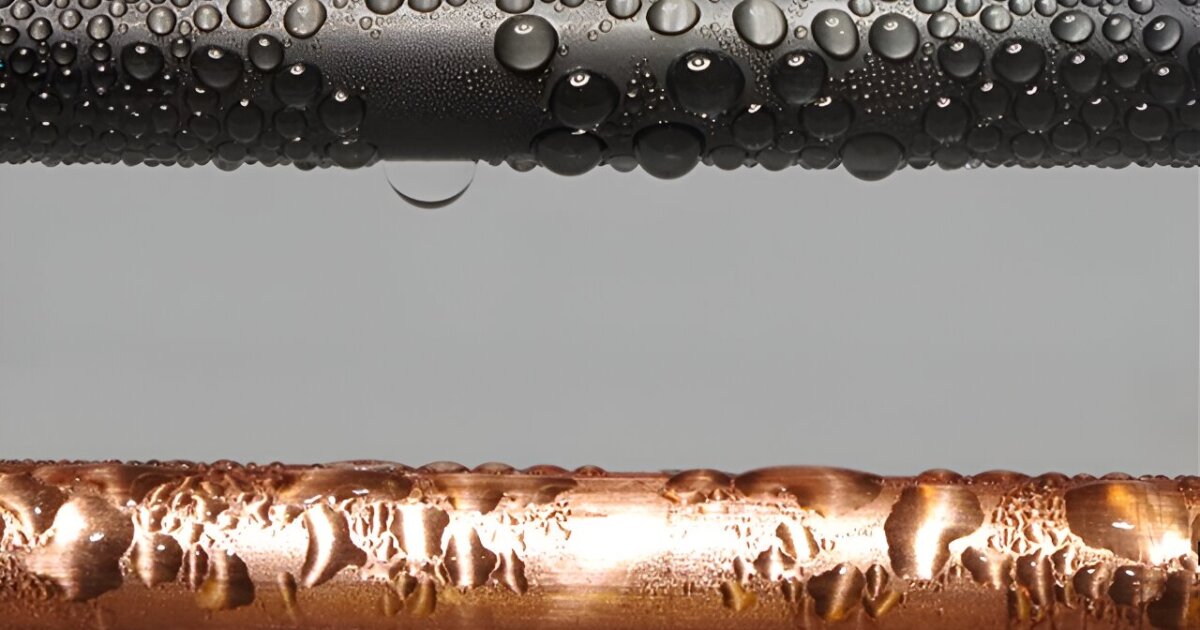This is a minor innovative being overly puffed to get clicks.
The number came from “if every power plant in the world was 2% more efficient, this is how much CO2 we’d save”.
This will not be deployed globally and there’s a lot of 2%s to be found outside the condenser. Including 100% reduction by shutting down fossil fuel plants.
Don’t underestimate the 1% effects, they add up. I agree it is unlikely they will get rolled out at mass, but everything helps.
Don’t know why you were downvoted, it’s true. I don’t believe in fossil fuels being burned either, but you may as well reach the same goal by improving what otherwise isn’t realistic to entirely remove. We won’t get anywhere without compromises, and we should continue to try to invest in cleaner energy, even if that means improving the existing dirty energy.
This works for nuclear too, and possibly thermal energy plants.
If we invested in nuclear and the public were actually properly educated without all the scary media scorn on it, we would have invested without so much resistance and be in a MUCH better place by now as it would have taken coal and gas off the grid. Here in the UK we have excellent renewable opportunities for wind, but we didn’t invest enough, nor did we invest enough in our own nuclear. When the pandemic hit, and the oil gas crisis happened, we were using 50-60% of our energy from GAS. We can’t turn them off or we’ll have brownouts, so it’s an uphill battle to get rid of our dependency.
Because our government didn’t invest in nuclear or wind or solar, and they didn’t put pressure on private energy companies to use alternatives, all the country got hit with enormous gas and electric prices. We sowed our own fate by not protecting the environment and pioneering alternative energy, and now our wallets finally pay the full price.
Saying that, the oil gas companies are minted now… Maybe we should punish the energy companies for not meeting their goals or promises, and for not taking responsibility for investing. You’d think taxes, but or Tory government wouldn’t want to harm their best pals in the energy business. Screw the government for that one. My bills are killing me.
These small improvements help still.
… steam is then collected in a condenser to reclaim the water to continue the cycle.
The researchers on the new study set out to improve the efficiency of the heat transfer of the condenser pipes. They developed a coating made of fluorinated diamond-like carbon (F-DLC), a material that’s hydrophobic, or water-repelling. When the steam condenses on the coated pipes, it no longer forms a thin film but balls up into droplets much more easily. That helps it run off faster, allowing more steam to come into contact with the pipe sooner.
Interesting approach.
Depending on the cost of it something like that could potentially also be used on air-conditioner evaporators to improve efficiency
Removed by mod
There is this new way for turning co2 into propane that I saw on hacker news. Maybe we can subsidize the process as a long-term energy storage solution instead of batteries? Would help with global warming and recapturing the burned propane(which turns into co2) is easy enough. Don’t know how viable it is, just a thought
Combusting fossil fuels has a peak efficiency of ~60% (around 40% for ICE).
I’ve no doubt it will likely be required for decarbonization, but I somewhat doubt it will be useful for grid electricity. It’s more likely (IMO) that the CO2->fuel route will mostly likely be used for things like airplane travel where the energy density of batteries is unlikely to get high enough to work well. (A battery plane with ~1hour flight is possible but it requires uber high density batteries). It might also be useful for generating fuel for shipping.
efficiency is not what I was thinking about. It was the fact that batteries usually have rare and expensive materials and cost of production, including high co2 from the manufacturing. The new process of converting co2 to clean burning propane is mostly self containing and cheap, without needing to dig up a lot of resources like batteries do. However, capturing co2 back to make the propane will prevent a lot of the co2 from entering the atmosphere. After all, we are trying to contain co2 from the atmosphere, and containing it in this circular system will be useful for combating global warming.
It was the fact that batteries usually have rare and expensive materials
Nope. The most common batteries, Lithium ion, are typically composed of absurdly common materials. The current darling for high capacity and low cost is LFP, which is primarily composed of iron. The higher density lithium batteries, NMC, the actual rarest material in those is the nickel.
Now, there are sourcing problems with the cobalt in NMC batteries. But that’s not really an availability problem, it’s more that cobalt has so little industrial applications outside of batteries that the primary source is artisan mines in the DNC. The fact, however, that it can be artisanly mined should tell you just how common it is. My home state (Idaho) is preparing to open an old cobalt mine. ( https://jervoisidahocobalt.com/ ) because the mining operation is betting on battery production continuing to ramp. They’ll be able to produce a lot more cobalt cheaper and without the human rights issues.
and cost of production
This is somewhat a problem but vastly outweighed by both recycling and the fact that batteries have at least a 10 year lifespan (likely a lot longer). Lithium ion batteries have anywhere from 1000 to 10,000 cycles for common chemistries. That is, a battery that can store 1kWh can emit anywhere from 1MWh to 10MWh over it’s lifespan (Likely more. Those cycle numbers are for batteries degrading to 70% of their total capacity). It takes around 50->60kWh of power to produce that 1kWh battery (just to put some numbers on it). So, after 50 to 60 cycles it’s payed back any sort of CO2 debt it’s incurred naively… After all the grid is mixed and complex. So it’s not as easy to say as that. It, after all, depends a lot on the power displaced by the grid and what the battery is replacing.
including high co2 from the manufacturing
The CO2 produced comes from power generation (from a baking process in the battery production). As the grid greens up the CO2 produced goes down. There’s nothing inherent in the battery production pipeline that requires CO2 emission… except maybe CO2 released from the concrete of new battery plants.
That CO2 cost is quickly payed off, especially in the case of grid storage.
The new process of converting CO2 to clean burning propane is mostly self containing and cheap, without needing to dig up a lot of resources like batteries do.
The same laws that apply to battery production CO2 emission would apply to CO2 -> propane conversions. The law of conservation of energy constrains us, it means the energy it takes to turn CO2 -> propane is at least equal to the amount of energy release from burning propane. That is, it takes a bunch of power to turn CO2 to an appreciable amount of propane (Not to mention this process almost certainly involves pure CO2 which means you also have to capture and separate the CO2 from the atmosphere, not an energy cheap operation, see atmospheric distillation). If you tally everything up, you’ll almost certainly find that the energy needed to make propane from CO2 far surpasses the amount of power a battery will emit over it’s lifetime. And the propane is one shot.
After all, we are trying to contain co2 from the atmosphere, and containing it in this circular system will be useful for combating global warming.
No arguments there and I absolutely agree that processes like this will be invaluable. I just don’t think it’s a good fit for grid storage. It’ll be a very energy intense process which should be reserved for generating a product where high energy density fuel is a requirement.
I’ve loved diving into green energy and power in general (My bachelor’s degree was electrical engineering and my interests have been green energy). There’s a fair bit of misinformation out there around batteries. They aren’t perfect, the best solution is not consuming power. But they also are some of the best options with modern power demands in my opinion.
Now, there are sourcing problems with the cobalt in NMC batteries.
They’ll be able to produce a lot more cobalt cheaper and without the human rights issues.I hope, NMC batteries are currently lower upfront cost but have less lifespan than LFP. However for a system that over compensates such as a grid storage vs single home, then it would be possible to make lifespan a less worrisome subject, especially if the NMC battery cost goes down. However, it seems both LFP and NMC will cost similarly in upfront cost in the foreseeable future.
I am worried about the lithium itself. its cost rose MASSIVELY in 2022 and this year in june & july, and unfortunately I don’t see it getting any lower in the near future.(even if it is half of what it was last year) While lithium is seemingly abundant, the cost of extracting it from mining it or the brine is staggeringly high. there seems to be new sources being explored but right now for the next ten years, lithium will be the largest factor in battery cost. As solving the lithium problem is a harder challenge, it may not happen within the next decade.It takes around 50->60kWh of power to produce that 1kWh battery… So, after 50 to 60 cycles it’s payed back any sort of CO2 debt it’s incurred naively… After all the grid is mixed and complex. So it’s not as easy to say as that. It, after all, depends a lot on the power displaced by the grid and what the battery is replacing.
truth, It all comes down to the fact that the power stored by the battery has to be renewable too. I do wonder about size too.
I won’t deny the energy in and energy out law of thermodynamics you mentioned. It is less energy costly to produce batteries. Still will be a need for a large amount of space dedicated to putting all of these batteries in one location. Plus you will have to carefully control the temperature and rotate out a battery that fails. A tank of propane has some limitations similarly but the range it can be in is vast and temperature won’t affect the performance as heavily. Meaning a tank of propane will be smaller in volume from an infrastructure standpoint. There will be less locations capable of having a large battery bank that can handle long period of high demand.
Another thought is the power generation from coal and natural gas is already constructed. Setting up a CO2 capture system and converting it into propane for long term storage, especially within space constraints of a city, is a lower cost than building the needed infrastructure and land space for batteries. when demand either out paces the renewable energy and nuclear sources, then the power plant can use propane instead of the coal, and when the propane runs out, a short time of burning some of the fossil fuels will be more beneficial than what happens when batteries run out. there is nothing that can be used to substitute batteries when they run dry. Another source of power will need to come online and stabilize into the system.
However, with all the talks about long term energy storage, there has to be an end to CO2 emitting power plants. Even with the propane system, the goal is to remove all emission of CO2 by scaling renewable or nuclear energy to meet the increasing demand. These long term storage systems are needed for times of increased average or peak power demand. or the loss of power generation. When there is a loss power generation that can take time to reconstruct/fix, then battery back up may seem unfortunately unequipped to handle the situation compared to just burning fuel. While the increased average power demand is more gradual, and peak power demand are short bursts. Battery and this propane storage system can both play a vital part if paired correctly to what is needed. Battery are more likely to assist with short bursts of peak power demands. On the other hand, propane storage is better suited for when average power demand goes up or the loss of a power source happens. a balance between these two will be more beneficial.
No arguments there and I absolutely agree that processes like this will be invaluable. I just don’t think it’s a good fit for grid storage. It’ll be a very energy intense process which should be reserved for generating a product where high energy density fuel is a requirement.
All in all, I have to refute the fact that converting CO2 to propane for grid power is not beneficial. It is not meant to be a product that can be regularly used. On the contrary, I believe it should be a last resort type of system when batteries run out of power/can’t meet demand spikes. batteries will be great for shorter occurences of power demand vs. the long term difficulties from a disaster or other problems that can take time to solve.
Just a few quibbles. NMC batteries have a higher cost than LFP with a shorter lifespan. The reason they are heavily used is because they have a higher energy density per pound. I’d expect LFPs to be used for grid/home storage because it’s cheaper up front and has a longer lifespan.
I’m less concerned about lithium because of its availability. A very tiny amount of lithium goes into batteries and it’s everywhere. The current brining method is unfortunate but there’s a ton of economical incentives to improve that. Even if it remains a mess, it’s relatively minor compared to other impacts like nickel mining.
As for space, not a major issue. Batteries can be stacked, buried, compressed in all sorts of interesting ways. You can easily produce the same power a current natural gas plant produces in the same square space.
Thermal management is a thing, but it’s easier to handle the more compressed you make the batteries.
Otherwise I think we are on the same page. I could definitely see propane for standby generation being a really good idea.
It is accessibility for repair and swapping batteries and the associated multitude of connectors that will need to be unhooked and reattached to a replacement. Thinking about repair and maintenance, that can worry me. replacing a battery is not as simple and, the whole pack will need to be replaced most of the time. There is a compromise between cost, ease of setup, maintenance, and compactness. Too compact and the whole thing will need to start coming apart to access the fault which is costly. I don’t see battery tech being less costly vs propane, they will about break even in the long run.
looking at the cost of a NMC battery, lithium just about matches or exceeds the cost of cobalt.(especially in 2022 where lithium was double its cost vs now) Cobalt is used less than lithium in the battery. I still think it is not the abundance of lithium but the cost of sourcing it from inefficient time consuming brine, or large mining operations that need to cover large areas as lithium is spread out. not to mention the environmental impact from mining it. After all battery production was supposed to help prevent more environmental concerns but sourcing it is just not great. global warming may be mitigated. Yet capturing CO2 is the most efficient at reducing environmental impact. Batteries are lower CO2 produced, but the impact of mining is nothing to scoff at.
looking at a cursory glance at wikipedia, li ion battery have lower energy density(KW/L) compared to Liquid propane. uncompressing propane will return it to a gas which is valuable because, the gas can more easily fired unlike gasoline where the liquid needs to be vaporized to turn a large volume into gas.(or coal where it needs to be pulverized) Natural gas power plants are far the easiest to retrofit a CO2 recycling system, by capturing, storing and using propane and switching to NG when propane runs out. Not to mention the charging time for batteries will always be larger than converting CO2 back to Propane.
I believe batteries should only be used for shorter term peak power demands. Propane storage from CO2 capturing is more likely to be accepted, easily transported to crisis areas that need longer time of power produced to rebuild necessary renewable or fixing the grid, and much better than batteries at reducing environmental impacts.
republicans will attempt to ban this substance on principal
Why do you think so?
The opposite, they’ll use this to act like “see, clean CO2 plants, let’s build more!”.





